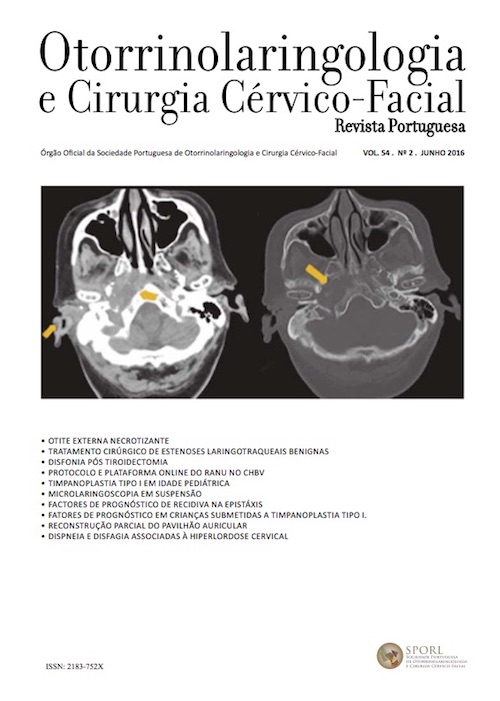Nosebleed recurrence prognostic factors
DOI:
https://doi.org/10.34631/sporl.387Keywords:
Nosebleed, recurrence, prognostic factorsAbstract
Objectives: To evaluate nosebleed recurrence prognostic factors.
Study Design: Retrospective observational study
Material e Methods: Inclusion criteria was nosebleed in ENT emergency department in 2013. Correlation with recurrence was tested for pathologic factors, nosebleed characteristics, treatment methods, seasonality, climacteric conditions, demographic factors, recommendations and hospital admittance need.
Results: We observed 549 nosebleed episodes from 396 patients with 27.9% recurrence episodes. In 17.3% patients were prescribed anticoagulants; 39.3% the nosebleed was active in the ED and hospital admittance was necessary in 9.8%. Recurrence prognostic factors included, anticoagulant medication, active nosebleed, coagulation disorders and smoking. Hospital admittance was a recurrence protective factor. No association between recurrence and any of the used techniques was identified.
Conclusions: Nosebleed recurrence negative prognostic factors included anticoagulant use, previous coagulation disorders, active nosebleed and active smoking. Hospital admittance was a positive prognostic factor. It’s of utmost importance to have them in consideration during nosebleed management.
Downloads
References
Soyka MB, Nikolaou G, Rufibach K, Holzmann D. On the effectiveness of treatment options in epistaxis: an analysis of 678 interventions. Rhinology. 2011 Oct;49(4):474–8.
Kucik C, Clenney T. Management of epistaxis. Am Fam Physician. 2005;71(2).
McLarnon CM, Carrie S. Epistaxis. Surg. 2012 Nov;30(11):584–9.
Kikidis D, Tsioufis K, Papanikolaou V, Zerva K, Hantzakos a. Is epistaxis associated with arterial hypertension? A systematic review of the literature. Eur Arch Otorhinolaryngol. 2014 Feb;271(2):237–43.
Spielmann P, Barnes M, White P. Controversies in the specialist management of adult epistaxis: an evidence‐based review. Clin Otolaryngol. 2012;382–9.
Ando Y, Iimura J, Arai S, Arai C, Komori M, Tsuyumu M, et al. Risk factors for recurrent epistaxis: importance of initial treatment. Auris Nasus Larynx. Elsevier Ireland Ltd; 2014 Feb;41(1):41–5.
Danielides V. The influence of meteorological factors on the frequency of epistaxis. … Allied Sci. 2002;170:84–8.
Rijal A, Maharjan S, Joshi R. Epistaxis and its Relation with Temperature and Humidity. Nepal J ENT . 2012;4–5.
Lavy J. Epistaxis in anticoagulated patients: educating an at‐risk population. Br J Haematol. 1996;(Fig 1):195–7.
Manfredini R, Portaluppi F, Salmi R. Circadian variation in onset of epistaxis: analysis of hospital admissions. BMJ. 2000;321(NOVEMBER):2000.
Saloheimo P, Juvela S, Hillbom M. Use of aspirin, epistaxis, and untreated hypertension as risk factors for primary intracerebral hemorrhage in middle-aged and elderly people. Stroke. 2001;32(2):399–404.
Soyka MB, Rufibach K, Huber A, Holzmann D. Is severe epistaxis associated with acetylsalicylic acid intake? Laryngoscope. 2010;120(1):200–7.
Hettige R, Mackeith S, Falzon A, Draper M. A study to determine the benefits of bilateral versus unilateral nasal packing with Rapid Rhino ® packs. Eur Arch Otorhinolaryngol. 2014 Mar;271(3):519–23.
Collins MM, Hawthorne M, El-Hmd K, Gray J. The subjective effects of smoking on nasal symptoms. Clin Otolaryngol Allied Sci. 1999 Aug;24(4):324–7.
Dedhia RC, Desai SS, Smith KJ, Lee S, Schaitkin BM, Snyderman CH, et al. Cost-effectiveness of endoscopic sphenopalatine artery ligation versus nasal packing as first-line treatment for posterior epistaxis. Int Forum Allergy Rhinol. 2013 Jul;3(7):563–6.
Pope LER, Hobbs CGL. Epistaxis: an update on current management. Postgrad Med J. 2005 May;81(955):309–14.
Toner J, Walby A. Comparison of electro and chemical cautery in the treatment of anterior epistaxis. J Laryngol Otol. 1990;104(August):617–8.






